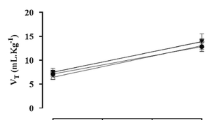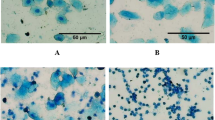Abstract
Estrous cycles and reproductive performance were compared among rats born at high altitude, rats of Berkeley stock transported to 3,800 m, and sea level controls. Disturbances of reproductive function observed in experimental groups were not due to reduced food intake. Estrous cycles of Berkeley stock at 3,800 m were normal, whereas cycles of high altitude native rats were irregular and fertility was impaired. Litter size was reduced in both groups at high altitude with fewer implantation sites than numbers of corpora lutea observed in the Berkeley stock rats at 3,800 m. In the high altitude native animals, numbers of corpora lutea correlated with implantation sites. Placentas from Berkeley stock rats (3,800 m) were heavier than those from the other groups, and fetal hematocrits from these animals were reduced.
Zusammenfassung
Der Oestruszyklus und die Fortpflanzungsleistung wurde bei drei Gruppen Ratten verglichen: (a) Kontrollen in Berkeley (Seehöhe); (b) Tiere der Berkeley-Kolonie in 3.800 m Höhe und (c) Tiere einer seit mehreren Generationen in 3.800 m gehaltenen Kolonie. Der Oestruszyklus der neu in die Höhe gebrachten Tiere war normal, während er bei den Tieren der höhenadaptierten Kolonie unregelmässig und die Fertilität geschwächt war. Die Wurfgrösse war bei beiden Höhengruppen kleiner. Bei den höhenadaptierten Tieren entsprach die Anzahl der Implantationsstellen der Zahl der corpora lutea, dagegen war bei den frisch in die Höhe verbrachten Tieren die Anzahl Implantationsstellen kleiner als die der corpora lutea. Die Placentagewichte waren bei den Höhentieren beider Gruppen kleiner und die foetalen Hämatokrits herabgesetzt.
Resume
On a comparé le cycle menstruel et la propension à la reproduction de trois groupes de rats placés dans les conditions suivantes: (a) un groupe de contrôle à Berkeley (niveau de la mer); (b) un groupe de la colonie de Berkeley transporté à 3.800 m d'altitude et (c) des bêtes vivant depuis plusieurs générations à 3.800 m d'altitude. Le cycle menstruel des bêtes nouvellement transportées en altitude est resté normal alors que celui des animaux acclimatés était irrégulier et leur fertilité diminuée. Dans les deux groupes d'altitude, le nombre des jeunes par portée était réduit. Pour les bêtes acclimatées à l'altitude, le nombre des implantations correspondait à celui des corpora lutea. On note par contre moins d'implantations que de corpora lutea chez les rats nouvellement placés en altitude. Le poids des placentas était inférieur pour les deux groupes d'altitude à celui du groupe de plaine et le taux d'hémoglobine réduit chez les foetus.
Similar content being viewed by others
References
ALTLAND, P.D. (1949): Effect of discontinuous exposure to 25,000 ft simulated altitude on growth and reproduction of the albino rat. J. exp.Zool., 110: 1–18.
ATHERTON, R.W. and TIMIRAS, P.S. (1970): Erythropoietic and somatic development in chick embryos at high altitude (3,800 m). Amer.J.Physiol., 218: 75–79.
BARRON, D.H., METCALFE, J., MESCHIA, G., HUCKABEE, W., HELLEGERS, A., and PRYSTOWSKY, H. (1964): Adaptation of pregnant ewes and their fetuses to high altitude. In: The Physiological Effects of High Altitude. W.H. Weihe (ed.), Macmillan, New York, 115–125.
CHANG, M.C. and FERNANDEZ-CANO, L. (1969): Effect of short changes of environmental temperature and low atmospheric pressure on the ovulation of rats. Amer.J.Physiol., 196: 653–655.
CHIODI, H. and SAMMARTINO, R. (1952): Fatty degeneration of the liver caused by high altitude hypoxia in young albino rats. Acta Physiol.Lat.Amer., 2: 228–237.
DAWES, G.S. (1968): Foetal and Neonatal Physiology; a Comparative Study of the Changes at Birth. Year Book Medical Pub., Chicago.
KELLEY, F.C. (1967): Neonatal mortality in rats born at altitude. Ph.D. Thesis, University of California, Berkeley.
KRUM, A.A. (1957): Reproduction and growth of laboratory rats and mice at altitude. Ph.D. Thesis, University of California, Berkeley.
LASKER, G.W. (1969): Human biological adaptability. Science, 166: 1480–1486.
METCALFE, J., NOVY, M.J. and PETERSON, E.N. (1967): Reproduction at high altitudes. In: Comparative Aspects of Reproductive Failure. K. Benirschke (ed.), Springer-Verlag, New York, 447–457.
MONGÉ, C.M. (1960): Aclimatación en los Andes. Extractos de investigaciones sobre Biologia de Altitud. Fac.de Med., Lima.
MOORE, C.R. and PRICE, D.J. (1948): A study at high altitude of reproduction, growth, sexual maturity and organ weights. J.exp.Zool., 108: 171–216.
NELSON, M.L. (1968): Thyroid function and hypophysial content of growth hormone and thyrotropin in rats raised at high altitude. Ph.D. Thesis, University of California, Berkeley.
TIMIRAS, P.S. (1964): Comparison of growth and development of the rat at high altitude and at sea level. In: The Physiological Effects of High Altitude. W.H. Weihe (ed.), Macmillan, New York, 21–30.
TIMIRAS, P.S., KRUM, A.A. and PACE, N. (1957): Body and organ weights of rats during acclimatization to an altitude of 12,470 feet. Amer.J.Physiol., 191: 598–604.
TIMIRAS, P.S. and WOOLLEY, D.E. (1966): Functional and morphological development of brain and other organs of rats at high altitude. Fed.Proc., 25: 1312–1320.
WEIHE, W.H. (1964): Some examples of endocrine and metabolic functions in rats during acclimatization to high altitude. In: The Physiological Effects of High Altitude, W.H. Weihe (ed.), Macmillan, New York, 33–42.
Author information
Authors and Affiliations
Additional information
This research was supported in part by NIH Grant NS-08989 and NSF Grant GB 3171.
Rights and permissions
About this article
Cite this article
Nelson, M.L., Srebnik, H.H. Comparison of the reproductive performance of rats at high altitude (3,800m) and at sea level. Int J Biometeorol 14, 187–193 (1970). https://doi.org/10.1007/BF01440962
Received:
Issue Date:
DOI: https://doi.org/10.1007/BF01440962




